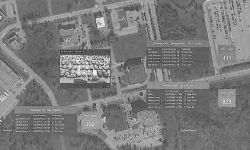MSU shooting 911 calls: McRae spotted in minutes; false tips prolonged ordeal

- Students hid in coolers, bathrooms and closets following the shootings
- Several witnesses shared suspect descriptions minutes after shots were fired, records show
- Suspect information wasn’t made public until 10 p.m. as dispatchers filtered out false tips amid record-level calls
LANSING — Students hid in closets, coolers and bathrooms. Parents sought help from 911 dispatchers to keep their kids safe. Residents reported everything they deemed suspicious, from passing cars to turning doorknobs.
An avalanche of callers dialed 911 minutes after the Michigan State University shootings on Feb. 13, according to call recordings and nearly 200 dispatch reports released this week.
The records, obtained through a joint records request by Bridge Michigan and The Detroit News, offer more clues as to how the gunman — Anthony McRae — eluded capture for several hours, even though witnesses provided dispatchers with descriptions of him and his general vicinity soon after the mass shooting.
Related:
- MSU shooting: Gunman had hundreds of bullets, walked away on busy streets
- Michigan State University 911 calls: Students broke windows to escape shooting
- MSU shooting survivor: I met ‘pure evil,’ played dead and pleaded for life
“I’m pretty sure the guy went out the back, the back on (the) Grand River (Avenue) side,” said a male caller who was inside the MSU Union when McRae shot one student in the food court there.
That call came in at 8:26 p.m., two minutes after police say McRae walked off campus after killing three students and critically wounding five others.
It would take MSU Police another 1 ½ hours to release a description of the suspect at 10:04 p.m. that would eventually lead to an encounter with police that ended when he killed himself 5 miles from campus.
Within an hour of the shootings, records reveal, callers from three fraternities reported a suspicious Black male pacing in front of a fraternity building.
At 9:14 p.m., a caller reported seeing a Black male with a blue hat and blue long sleeve shirt on Grand River and Harrison.
At 9:20 p.m., a caller reported a similar description of a man in a hat carrying a brown bag and “acting very oddly and … pacing around in front.”
All matched McRae.
‘Numerous conflicting reports’
MSU Police couldn’t issue an alert until his description was verified, and there were “numerous conflicting reports” about the suspect early in the night, department spokesperson Dana Whyte told Bridge in a Wednesday email.
“With the volume of calls being placed and the magnitude of information being reported, the department wanted to make sure this description was accurate before sharing it with the public,” she said.
Several callers may have reported McRae’s whereabouts, but police couldn’t share them because his “complete route” off campus was unclear that night and dispatchers were busy fielding calls with accurate and inaccurate tips, Whyte said.
“There was no way to differentiate between accurate and inaccurate information at the time that the calls were received,” she said.
The call volume was “significantly higher than any other incident on campus in department history,” Whyte said.
MSU Police and other law enforcement agencies responded to “each individual call on or near campus” the night of the shooting, dispatching the closest officers to each call, she said.
Indeed, the records show that for every accurate tip, there were several others that may have led in different directions.
One caller complained of someone “trying doorknobs” in the Bryan Hall dorm. Multiple others reported a black truck “pulling up” near a separate dorm.
Throughout the ordeal, thousands of students and residents sheltered in place for hours, until shortly after midnight on Feb. 14 when police announced that McRae had killed himself on Lake Lansing Road near High Street, near his home in Lansing.
The encounter came not long after a caller dialed 911 after seeing a man matching the description of the MSU gunman.
“I’m about to have a heart attack unless I get some kind of information,” one caller told dispatchers at 8:39 p.m.
“How far are they from here? I need to know what my options are,” he asked, referring to rumored multiple shooters, which the police ruled out.
“Lock down and barricade yourself in any room that you are in,” the dispatcher said.
University of Michigan Psychology Professor Sandra Graham-Berman said uncertainty can add to trauma: “The longer (it) goes on, the more likely people are to be troubled by it and worried about it.”
She attributed the surge in 911 calls to people “becoming hyper aware of their surroundings, being on guard for more traumatic events, a sharpened focus on who and what is around them.”
“People do this in order to protect themselves from surprise, from harm, or from harm to others,” she told Bridge in an email.
Chaos descended on MSU
The records that have been released are far from complete. Bridge and The News first requested the 911 calls through the Freedom of Information Act the day after the shooting.
Three months later, Ingham County officials have only released 67 audio files covering the first 27 minutes after the shootings.
Bridge and The News were also able to piece together a better account of the timeline through dispatch reports made by 911 operators that summarize calls and interactions with police agencies.
Though incomplete, the calls give a glimpse into the horror and confusion at MSU.
Minutes after the massacre, a female caller told a dispatcher she was hiding in the cooler at the MSU Union food court, where Brian Fraser, 20, a student from Grosse Pointe Park had just been killed.
At 8:27 p.m., another female caller told the dispatcher she works at the MSU Union front desk and was calling from the mailroom. She said she could hide in the “lost and found closet.”
“I’m scared. I’m shaking,” she said, crying.
Others told 911 operators they were hiding in bathrooms, classrooms and a computer lab.
“It sounded like shots fired in the food court. We heard three loud bangs and everyone started running,” one male told a 911 dispatcher, saying he was hiding behind a car engine block. “There are already officers here.”
Within minutes of the first reports of a shooting, parents of students began calling 911. One mother asked a dispatcher what her son should do after he ran out of the MSU Union building following the shooting.
“What do we tell our child? Just to stay put in the bushes?” she asked.
“If he can leave the bush, go and talk to the officer and have their hands up,” the dispatcher responded.
Authorities in March released the first 10 911 calls from Berkey Hall, where the gunman killed students Arielle Diamond Anderson, 19, of Harper Woods, and Alexandria Verner, 20, of Clawson, and injured others in Room 114.
The records show some students trying to escape the building by breaking the windows while others worried the opening was too narrow for them to fit through. Some said they could not lock the doors from within, and one female caller said students tied the door shut.
Michigan Education Watch
Michigan Education Watch is made possible by generous financial support from:
Subscribe to Michigan Education Watch
See what new members are saying about why they donated to Bridge Michigan:
- “In order for this information to be accurate and unbiased it must be underwritten by its readers, not by special interests.” - Larry S.
- “Not many other media sources report on the topics Bridge does.” - Susan B.
- “Your journalism is outstanding and rare these days.” - Mark S.
If you want to ensure the future of nonpartisan, nonprofit Michigan journalism, please become a member today. You, too, will be asked why you donated and maybe we'll feature your quote next time!





